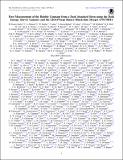First Measurement of the Hubble Constant from a Dark Standard Siren using the Dark Energy Survey Galaxies and the LIGO/Virgo Binary–Black-hole Merger GW170814
Author(s)
The DES Collaboration; LIGO Scientific Collaboration; Virgo Collaboration; Aggarwal, Nancy; Barnum, Sam; Barsotti, Lisa; Biscans, Sebastien; Buikema, Aaron; Demos, Nicholas; Donovan, Frederick J; Eisenstein, Robert Alan; Evans, Matthew J; Fernandez Galiana, Alvaro-Miguel; Fishner, Jason M.; Fritschel, Peter K; Gras, Slawomir; Hall, E. D.; Katsavounidis, Erotokritos; Kontos, Antonios; Lane, B. B.; Lanza Jr, Robert K; Lynch, Ryan Christopher; MacInnis, Myron E; Mansell, Georgia; Mason, Kenneth R; Matichard, Fabrice; Mavalvala, Nergis; McCuller, Lee P; Mittleman, Richard K; Ray Pitambar Mohapatra, Satyanarayan; Ng, Kwan Yeung; Shoemaker, David H; Sudhir, Vivishek; Tse, Maggie; Vitale, Salvatore; Weiss, Rainer; Whittle, Christopher Mark; Yu, Hang; Yu, Haocun; Zucker, Michael E; ... Show more Show less
DownloadPublished version (1.115Mb)
Publisher Policy
Publisher Policy
Article is made available in accordance with the publisher's policy and may be subject to US copyright law. Please refer to the publisher's site for terms of use.
Terms of use
Metadata
Show full item recordAbstract
© 2019. The American Astronomical Society. All rights reserved. We present a multi-messenger measurement of the Hubble constant H 0 using the binary-black-hole merger GW170814 as a standard siren, combined with a photometric redshift catalog from the Dark Energy Survey (DES). The luminosity distance is obtained from the gravitational wave signal detected by the Laser Interferometer Gravitational-Wave Observatory (LIGO)/Virgo Collaboration (LVC) on 2017 August 14, and the redshift information is provided by the DES Year 3 data. Black hole mergers such as GW170814 are expected to lack bright electromagnetic emission to uniquely identify their host galaxies and build an object-by-object Hubble diagram. However, they are suitable for a statistical measurement, provided that a galaxy catalog of adequate depth and redshift completion is available. Here we present the first Hubble parameter measurement using a black hole merger. Our analysis results in , which is consistent with both SN Ia and cosmic microwave background measurements of the Hubble constant. The quoted 68% credible region comprises 60% of the uniform prior range [20, 140] km s-1 Mpc-1, and it depends on the assumed prior range. If we take a broader prior of [10, 220] km s-1 Mpc-1, we find (57% of the prior range). Although a weak constraint on the Hubble constant from a single event is expected using the dark siren method, a multifold increase in the LVC event rate is anticipated in the coming years and combinations of many sirens will lead to improved constraints on H 0.
Date issued
2019Department
LIGO (Observatory : Massachusetts Institute of Technology); Massachusetts Institute of Technology. Department of Physics; MIT Kavli Institute for Astrophysics and Space ResearchJournal
Astrophysical Journal Letters
Publisher
American Astronomical Society